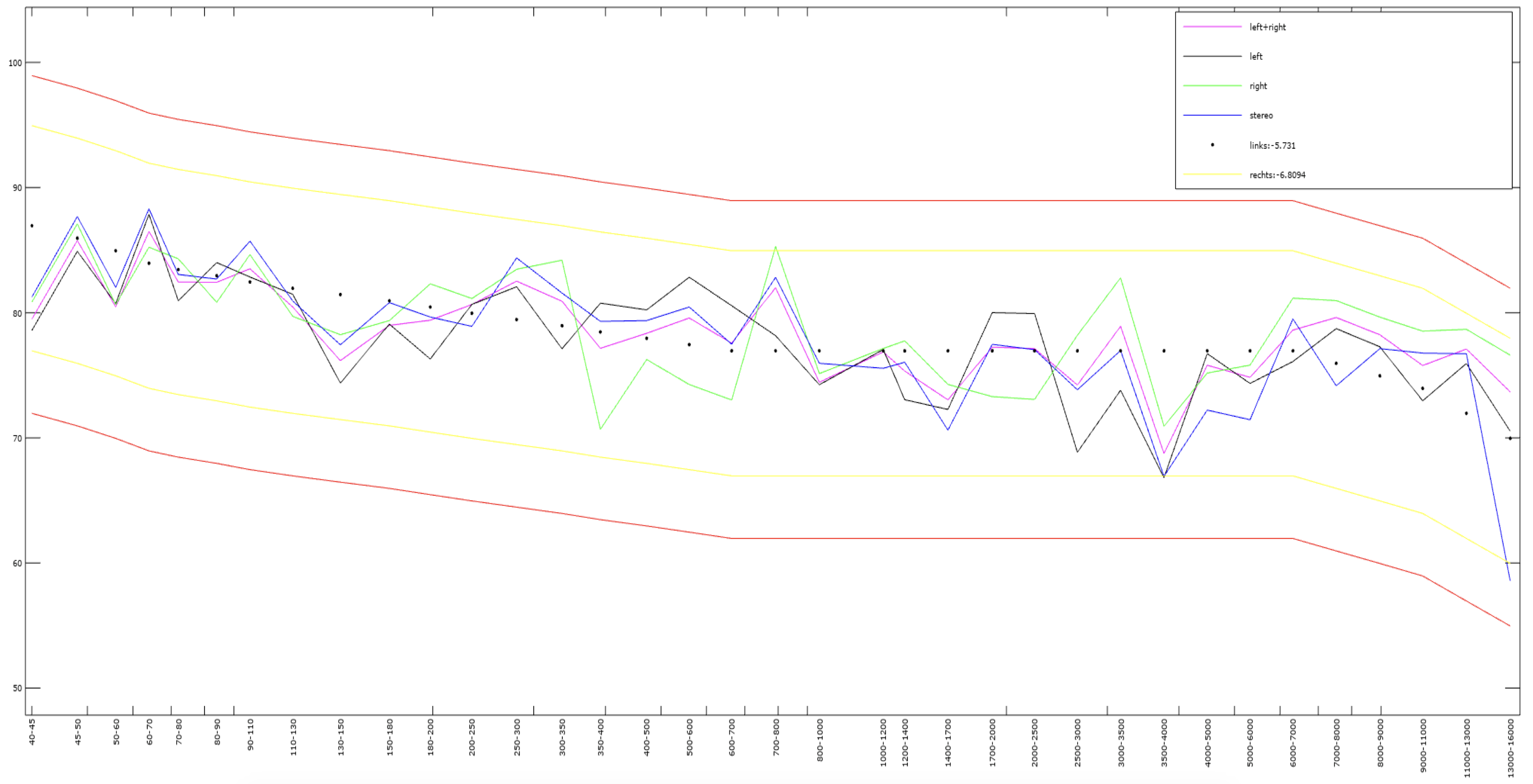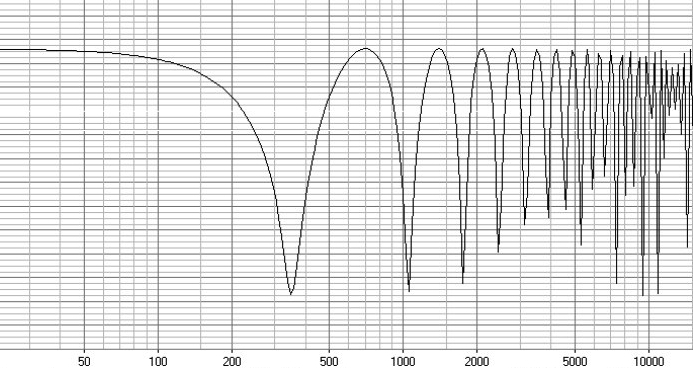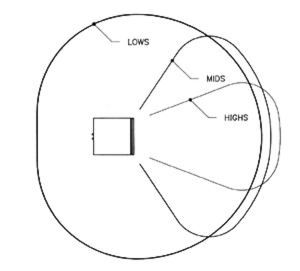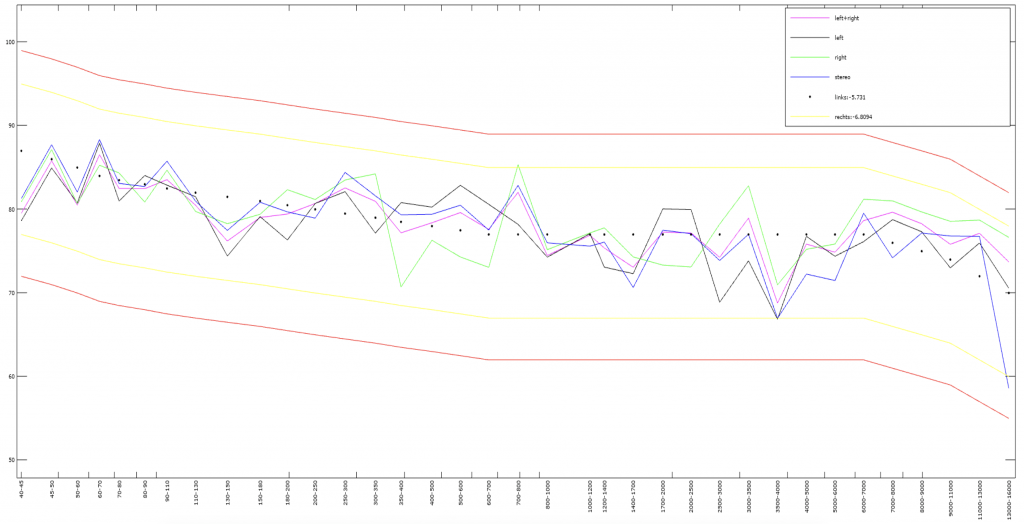
Flaws in audio at listening position – frequency response
![]() Text to speech – TestHiFi blog: Flaws in audio at listening position – frequency response
Text to speech – TestHiFi blog: Flaws in audio at listening position – frequency response
Theory explanation 
Frequency response amplitude drops or peaks at listening position
Frequency response is used to describe the output of an audio system. It represents the amplitude response for each frequency in a range, mostly between 20Hz – 20.000Hz. An audio system should play back an input signal that has a constant amplitude level across the whole frequency range, for every tone in the frequency range, with the same output amplitude level. Any deviation from this output amplitude level would represent a manipulation by the audio system. The flat response is the universal reference for translating the tonal balance of the musician’s original intent to any sound system and between sound systems. No matter if you are listening to a system in your car or to a system in your living room.
An audio system accelerating or attenuating some tones
This consequently misrepresents the musician’s original intent. Frequency responses might not be accurately flat on purpose. This allows to receive warmer, bass heavy or brighter sound, depending on your preferences.
A frequency response of a system is pretty flat if all amplitudes of the frequencies between 20Hz and 20000Hz are in a range of +- 3dB. Consequently, the difference between the loudest and the most quiet tone could still be up to 6dB in such a flat response. While a difference of 10 dB is perceived as doubling the loudness of a tone.
A frequency response should be correct
Independent from individual preferences, no tones should be significantly accelerated over the others in a frequency range of an audio system. If there are amplitude differences of 20dB or more, in the range of 70Hz up to 15000Hz (easier to hear than 20Hz-20kHz), these tones would color the tonal balance during the listening experience.
The ideal frequency response at listening position is not flat
Measuring positions influence the optimal measurement targets, despite the fact that an audio system should deliver an exactly the same frequency response it receives as an input as an output. In an anechoic chamber there are no audio reflections, therefore an audio system output can be measured, with almost no room influence to it. At the listening position we measure the audio system output always including all room influences, respectively all ambience influences. An expected „flat“ frequency response leads to a subjective understatement of lower and a subjective higher presence of upper frequencies. The ideal frequency response is slightly lifted for lower and decreased for upper frequencies at listening position. We perceive this as a subjectively flat frequency response at the listening position.
Why is the listening frequency response not flat
This certainly also relates to comp filtering. The delay between direct and reflected sound is the same for all frequencies. Floor reflexion cancels some frequencies, contained in the direct sound of the loudspeaker and boosts others.
The lowest frequency „f“ cancelled is determined by its halve-wavelength being equal to the geometric delay between direct and reflected sound. Twice that frequency (2*f) will be reinforced by the reflexion. 3*f will be cancelled, 4*f reinforced, 5*f cancelled, and so on. On a linear frequency scale, the effect of the delayed reflexion on the direct sound’s spectrum looks like that of a comb.

Usual living rooms add hundreds of delayed reflexions to the „direct sound“ generated by the loudspeakers.
Speaker Directivity*
Speakers possess frequency-dependent directional qualities. For both, mids and highs, they produce adequate sound levels only in the forward direction towards the listener. Lower frequencies from the same speakers, however, radiate equally in all directions. This directionality means that mids and highs are efficiently beamed towards the listener, and little acoustic energy is wasted on illuminating the rest of the room.
The lows easily require six or more times the acoustic/electric power than the mids and highs to achieve the same sound level at the listener’s position. Speaker efficiency is one reason for power gulping. The other is directionality. As bass waves are bigger than the speaker, they travel with equal strength in all directions. The speaker is an “omni” pattern sound source. Often much of the bass wavefront has bounced off of the walls, floor and ceiling of the room before it even reaches the listener.

*By Arthur M. Noxon: Sound is acoustic energy and rooms store this energy. Resonance is nature’s most efficient way to store acoustic energy in a room. Resonant energy easily lasts two times longer than sounds that are not resonant, and this is how the coloration of sound occurs in small rooms. Originally written and published in dB Magazine, November/December 1991
Direct sound, reflection and ambient noise
The sound we hear at the listening position should be dominated by the direct sound from the speakers. However it is always, except in an anechoic chamber, combined with some ambient noise and the incredible amount of reflections that exist in any usual listening room. This holds true also for professional sound studios or highly equipped listening rooms.
Room acoustical design
There is no general rule how to design a listening room. How much reflected energy improves or harms our impression? From which direction of incidence, and how much delay? Diverse concepts are used in studios as well as at homes. There exist only few AES papers about this. It seems that different music prefers different room contribution. Similar to life music: Classical concert halls are more reverberant than multi-purpose halls. Consequently there is no general rule on how to adjust the frequency response ideal curve. However here is an example on how TestHiFi does the adjustment to the frequency response.

Impact on listening 
The perceived frequency response amplitude at the listening position might include lower or higher amplitudes than the subjectively perceived ideal frequency response.
Differences in loudness across a key board of a piano
Lets stroke every key on a piano keyboard, one after the other, with the same strength. This should not give us some tones less loud than others. That would be a flaw in the piano that needs to be repaired.
A system with severe frequency response amplitude drops or peaks would play some tones less loud or more loud than others. This would be a harm to your music experience at the listening position, and as such not HiFi.
Drops and peaks
How such frequency amplitude drops or peaks influence the listening experience in principle is described for the two criteria frequency response amplitude drops (link) and frequency response amplitude peaks (link).
Listening position „non flat“ frequency response
Although the ideal frequency response at the listening position is not flat, measured amplitudes should not diverge much from the indicated dotted average. Systems which deliver amplitudes for lower frequencies underneath the dotted line sound rather less deep and punchy in bass. Those that deliver upper frequencies above the dotted line sound rather sibilant, shrill and brittle.
The ambience noise influence on listening
Listening tests or measurements can hardly identify frequencies with their amplitude value, their loudness being below the loudness of the ambience noise. You can hardly hear those tones, respectively separate them from the ambience noise (no value).
What can I do? When … an audio system 
… buying …
Choose your system in accordance with your listening preference
The first and foremost important thing is knowing what you want. Systems might be for example basshead, warm, bright or neutral. The frequency response curve will indicate if the weight is more on the lower (basshead), midrange (warm) or higher frequencies (bright).
Choose a system without flaws or tricks
A system might have flaws in form of drops or peaks that negatively influence your listening experience. Position or adjust the system to cover for this flaw. There are several “tricks” available to seemingly make a system sound good. Any severe amplitude drops in the frequency range would be a significant compromise.
Example:
Bass levels of a speaker with rather low bass levels appear higher if positioned in a corner, surrounded by stone walls. When listening to some test music in a store, while in discussion with the seller and obstructed by the store ambience, it might sound appropriate. Back at home, the speaker is in a totally different environment and position, away from any strong reflecting material. Subjectively, the speaker still might not sound unbearably bad. However a speaker with appropriate bass levels most probably would sound much better.
Making purchase decision on well selected, appropriate and objective criteria allows for better and more sustainable compromise.
… setting up …
Where to place a speaker for the right compromise
Positioning of your speakers might influence the loudness of some tones. It can make them louder or less loud, i.e. accelerate some tones and attenuate others. Also important is the material, i.e. which carries a speaker, which surrounds a speaker and which is in front of the speaker on the ground.
A speaker positioned closely surrounded by walls and the floor, like a stand speaker in a corner and a thick carpet in front, might be more bass heavy. The second stand speaker positioned on the other side of the living area, being open to another room and not close to a wall, might sound a bit less bass heavy.
What to place the speaker on for the right compromise
Positioning of speakers matters, e.g. positioned on the floor, on a shelf or on anything that might cause resonances. Those resonances would be measured as distortions and sound very odd.
Speakers positioned high up from the floor might deliver less trebles. If positioned low they might deliver less trebles and less bass. The speakers output for higher frequencies should be horizontally and vertically geared towards the listening position.
Plenty of measures to improve sound at listening position
Optimize speaker distance towards walls.
Find best position for the speakers, because this is important especially for lower frequencies. The position close in a corner accelerates low frequencies, free standing in a room attenuates lower frequencies.
Improve speaker vertical and horizontal tilt. Speakers posses higher and mid range frequencies more narrow in a forward direction.
Adjust the distance of the speakers to a listener and to the floor. Cancelation effects attenuate lower frequencies, if the distance to the listening position combined with the distance to the floor and the resulting floor reflection, match frequency lengths (comb filtering).
Move listening position to the tip of the equilateral triangle. In order to receive optimal stereo effects and most equal frequency ranges, create an equilateral triangle of the listening position together with the left and right speaker.
Influence the room design with absorption, i.e. by applying specific absorption material to reduce reflections, at places that reflect certain tones. Different frequencies require different absorption materials. As a thumb rule, the lower the frequency the thicker the absorption material.
… listening to …
If at your listening position the frequency response is not flat enough, check if the lower / higher amplitude areas at the listening position align with the drop / peak areas of your system. Alignment might be regarding amplitude, frequency area, or both. Room acoustic influences may have some impact at the listening position for cases with non-alignment.
Usage of an equalizer: equalizer allow to attenuate or accelerate amplitudes of specific frequency ranges. This is an option in order to compensate drops or peaks in a frequency range at listening position.
(This measurement criteria relates to measurement at listening position- future version of TestHiFi)